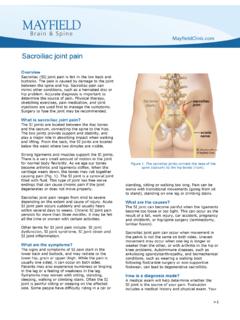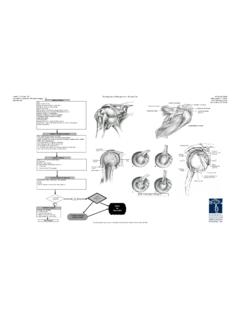Transcription of Denise Bickel DVM Distal Hock Arthritis
1 Distal Hock Arthritis It is important to understand a bit about the anatomy of the hock in order to understand how and why hock Arthritis de-velops. The horse s hock is analogous to our ankle. It is made up of many small bones and 4 joints. The largest joint is called the tibio-tarsal joint. This is the joint you see mov-ing when the horse moves. This large joint is a motion joint: it allows the leg to bend at that hock. There are 3 other joints in the horse s hock, though. From the outside, we do not see these joints move at all. These joints are the Proximal intertarsal, Distal intertarsal, and tarso-metatarsal joints. Each joint represents a very small space between layers of the small bones of the hock. These joints are shock absorbing joints. They absorb the impact as the horse moves. Because these joints are very narrow to start with, and because they absorb a lot of shock, over time, the carti-lage in these small joints begins to wear away.
2 When the cartilage begins to wear, we get bone on bone contact. Bone on bone contact is pain-ful and ultimately the cause of all Arthritis pain. This bone on bone contact stimulates the breakdown ( lysis) of some bone and the creation of new bone in areas of irritation ( osteo-phytes or spurs ). This results in visible changes on radiographs. However, it is important to remember that horses can be very painful with relatively mild radiograph changes, or alter-nately sound with relatively severe radiograph changes. THE ARROWS SHOW CHANGES IN THE Distal INTER- TARSAL JOINT INCLUDING LYSIS(YELLOW ARROW), SPURS (BLUE AR-ROW) AND LOSS OF JOINT SPACE( RED ARROW) Denise Bickel DVM Whole Horse Vet Services If radiographs alone are not sufficient to identify hoc Arthritis , how do we identify it ? A lot of the diagnosis is dependant on a complete lameness exam. Horses with hock Arthritis move in ways to reduce the impact on the hock joints.
3 They will show reduced action in the hocks, bending the hocks only slightly as they move. Some horses with hock arthri-tis even drag their toes and some will occasionally stumble. They may show a hip hike or hitch in the hind end if one side is significantly more painful than another. In addition, horses with hock Arthritis often show behavior problems. One of the most common of these is refusing the canter, or bucking at the canter. Refusing jumps or resisting gait tran-sitions can also be characteristic of these horses. Horses with hock Arthritis consistently respond to the Spavin test. This involves flexing the hock by holding up a hind leg for about 60 seconds, then trotting the horse off. Horses with hock Arthritis will show a pronounced pain response. In addi-tion, we will sometimes perform a diagnostic nerve block for diagnosis. This involves injecting a small amount of local anesthetic ( similar to novacaine) directly into the hock joint.
4 This numbs the area, and if the pain is coming from the hock joint, the horse will show a big improvement in lameness. Hock pain can be managed in multiple ways depending on your finances and goals: 1. Joint injections: these are the fastest and most effective way to treat hock Arthritis because the medication goes directly into the joint. The horse will be improved in 3-5 days after injection. Usually hock injections need to be repeated every 6 to 12 months. Although every precaution is taken , there is a very small ( .3%) risk of a joint infection which can be very serious. This is often the best treatment for hock Arthritis but owners must understand that there is a very small risk involved 2. Injectable joint supplements ( Adequan, Legend, Pentosan, etc) These are given every 2 to 4 weeks for effect. It can cost $600-1200 a year to do these. If you are able to do your own injec-tions, sometimes this can reduce the cost some.
5 They are relatively safe although a small risk of allergic reaction exists. Usually it takes 3-4 weeks to see an effect and the effect is often not as profound as from joint injections 3. Oral joint supplements/anti-inflammatories. These are oral supplements that must be given daily. They are usually the least expensive option: however, it can take 4-6 weeks to see an effect, making them a poor choice for horses who are actively competeing.. They are also very safe. Usually we recommend a joint supplement with 10,000 mg MSM, 2500 mg chon-droitin, 2500 mg glucosamine . We also recommend giving BL solution which is,a homeo-pathic antiinflammatory that is safer than bute. It also must be given daily. Oral supplements alone may not be enough to help a horse with severe hock pain. 4. There is a surgical option but it is only effective if the Arthritis pain is centered only in the DIT joint. Therefore we recommend a joint block prior to referral.
6 This surgery is called a cunean tenectomy or "jack cord surgery". It is very effective in those cases where the Arthritis arises only from the DIT joint. It will not help horses with pain arising from the other hock joints. Most horses can continue to work with proper treatment, and most horses eventually will fuse and become more comfortable Denise Bickel DVM Whole Horse Vet Services 517-474-4050 Info@wholehorsevetservices,com






